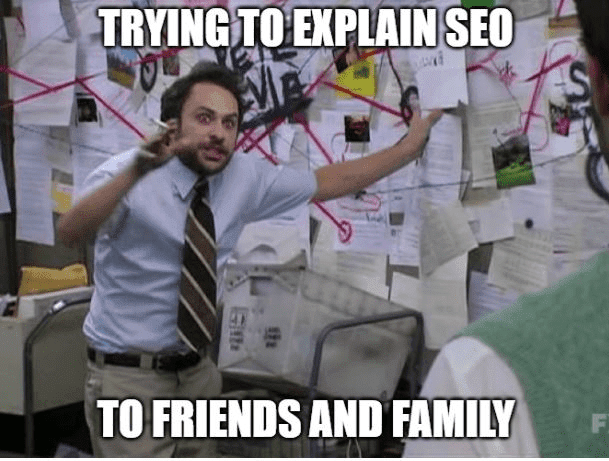A 453% increase in website traffic.
A 1400% increase in organic traffic.
A 200% increase in meetings booked monthly.
A 100% increase in revenue.

When Topflight was first launched in 2016, we focused heavily on using word-of-mouth and letting the quality of our work help expand our opportunities for us. Our main source of traffic, leads and customers was our existing network, word-of-mouth from current and past customers, and a very small percentage that came in through organic search.
Toward the end of 2019 it became clear that just that method to tap into the market would not suffice, and that it was time to pray to the marketing gods to really expand on reaching out to our potential market online.
It was around that time, COVID hit and pretty much everything was virtual, and we knew now more than ever we really needed to increase our online reach. Not just because the world around us changed in a blink and went completely digital, but because now more than ever our potential customers would be looking for services like ours, i.e. making healthcare more accessible, building products that would enable people to get what they need via a click on their phone from home.
So we really had one goal – Make it easy for people that need us, to find us.
And find they did.
Overall traffic growth

Organic traffic growth

How did we make the above happen?
Blood, sweat, and tears.
Na, it really wasn’t that intense.

Just a strategic, focused, experimental approach with well defined goals.
I remember having started my journey with Topflight back in May of 2020, and distinctly remember our CEO, Joe mentioning how one of Topflight’s biggest struggles was “Traffic is stagnant”.
And the very first thing I did was to create a revenue goal for us that year based on further conversations with the team, and then working backwards from that revenue goal, to make it a leads and traffic goal.
After that SMART goal, my next goal was to get the team together so we can put all the missing pieces together, focus on that goal, and work together to achieve that. And here’s what happened.
We saw a 100% increase in revenue in the 2 years since we launched a focused marketing strategy of which close to 65% can be attributed to growth via online marketing.
But why are we sharing 7 figures worth of marketing secrets with you? Why are we sharing years months upon months of experiments to share with you what finally worked?
To showcase to app builders everywhere , the power of marketing and how it can help scale businesses.
We’ve seen hundreds of promising apps, but the difference between the ones that are successful and not, is also recognizing the importance of investing time and money into marketing.
If you don’t really care about getting into the actual nitty gritty, here’s my top 3 takeaways:
- Get Help – If you’re a founder, you don’t have to do everything. Hire people that are experts in their respective fields, and care about meeting their goals, and it’ll save you tons of time and money, while helping you grow faster.
- Be Open-Minded – One of the biggest reasons I was able to successfully lead this growth mission was having a management that was supportive and open to experimentation. If you hire individuals to lead your teams, give them the autonomy they need to be successful.
- Understand the real work begins after launch: It pains me to see some founders spend all they have into building their products without understanding they need to market it. What good is a brilliant app that only you and your dog know about? Make sure you plan beyond the launch and include a strategic marketing plan right at the start.
Here’s a quick overview of our process.
- Build Keyword List
- Create Content Calendar
- Follow SEO Checklist
- Publish Content
- Analyze, analyze, analyze
- Revisit old blogs
- Continue expanding growth
Let’s jump right in.
Build Keyword List
The very first step was making a list of the keywords we wanted to be found for.
For example, someone searching for “healthcare app development” should see Topflight right at the top of that Google search.
What was important here was to not just make a list of keywords relevant to our business and services, but a list of keywords that those looking to do business with us would find us for.
And here’s why this is important.
The keyword “healthcare app” has around 5,000 people in the United States searching for it on a monthly basis. The keywords “healthcare app development” has around 200 people in the United States searching for it on a monthly basis.
So, what keyword do we want to rank for?
The one with the higher search volume, so more people can find us, right?
Nope.
We want to rank for the keywords that would bring us business, and we call them “highly commercial intent” keywords. So what was important was ensuring the keywords we pick have the right intent.
So here’s a summary of the first part of the process:
- We got together as a team to figure out what verticals we needed to focus on.
- Reviewed existing clients to understand what sectors the maximum ROI came in from.
- Made a list of competitors and used a tool like ahrefs, or Semrush for organic keywords they’re ranking for to get more keyword search ideas.
- We were also using Upwork to pitch our services and the job listings there worked as a great source to get new keyword ideas for our existing buyer persona.
- We reviewed the keywords existing clients used when they initially reached out.
- We talked to the sales team to get deeper insights into common terms used by leads.
- Using steps 1-6, we created an ideas list which looked somewhat like this
 We used the above ideas, and inputted those into the Google Keyword Planner to get additional ideas based on our research.
We used the above ideas, and inputted those into the Google Keyword Planner to get additional ideas based on our research.- This is important because while relevance matters, we also needed to ensure there’s actual demand for some of these keywords.
- Once we had our preliminary keywords list, the next step was researching those keywords on Google to see what kinds of results popped up. Why that was important, was because the type of results that pop up will also give you insights into what people are looking for based on those keywords. For example, here’s the difference in search results for “fitness app development”, and “fitness app builder”.
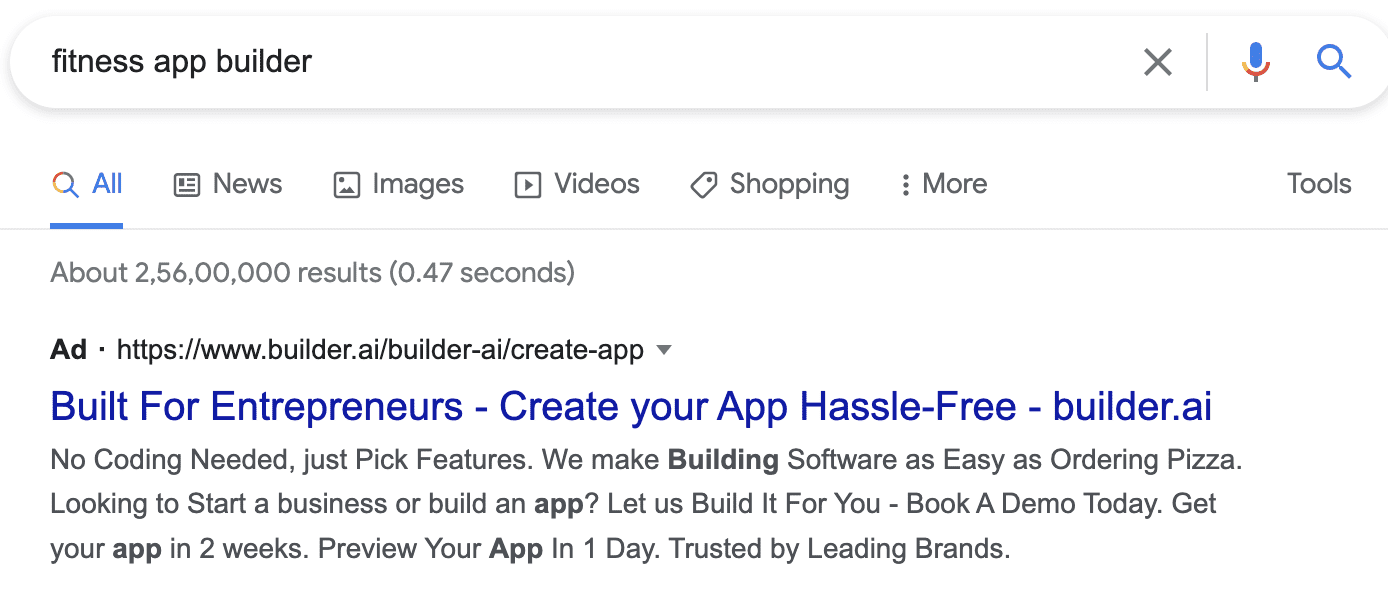
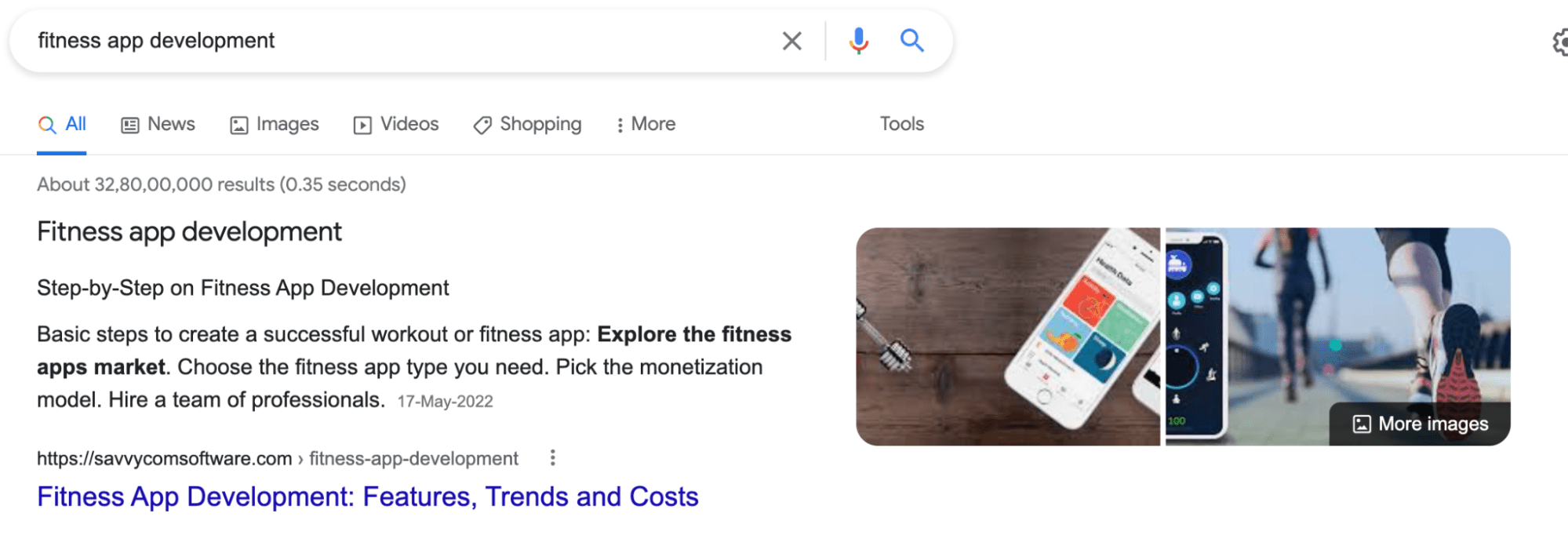
And that’s pretty much it. Steps 1-10 should give you an initial list of 10-20 keywords to get started with, and every time you’re looking for commercially relevant keywords to rank for, repeat steps 1-9.
Create Content Calendar
Once we’ve got the list of keywords we want to be found for, the next step is creating the relevant content. The goal is to have one page per keyword cluster.
For example, if you have a few keywords around fitness app development on your list (this would include keywords like build fitness app, workout app development company, find fitness app developers), you’d create one topic for what’s called this “keyword cluster”.
Once we have a bunch of clusters, for example a healthcare app development, fintech app development, fitness app development – we create corresponding content for each of those keyword clusters.
There’s 2 main types of content pages – a pillar page, and a supporting page.
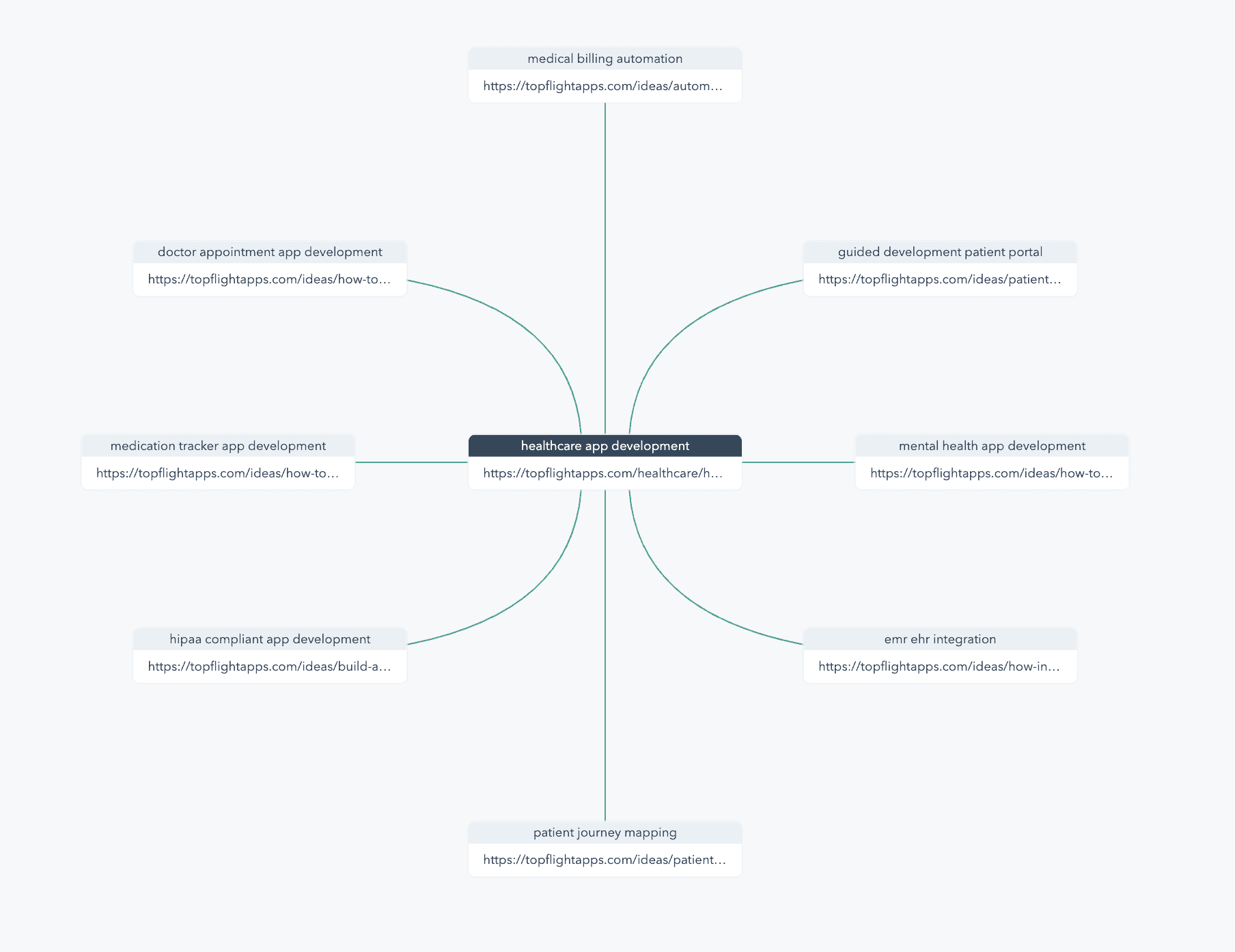 In the above image, healthcare app development is the pillar page, and sub topics such as mental health app development, patient journey mapping, etc are considered sub topics. The idea is to make sure the pillar page and supporting pages are connected via an interlink (more on this later).
In the above image, healthcare app development is the pillar page, and sub topics such as mental health app development, patient journey mapping, etc are considered sub topics. The idea is to make sure the pillar page and supporting pages are connected via an interlink (more on this later).
There’s several tools out there like the SEO tool in HubSpot that helps you pick topics that will be relevant to your audience. Google Search Console is also a great place to find blog topic ideas based on keywords, because it tells you exactly what your audience is searching for.
Follow SEO Checklist
When it comes to SEO Optimization, we focused on all three elements – On Page, Off Page, Technical SEO. I’ll do my best to keep this brief and high level so you’re not lost and it makes sense.
On-Page SEO and Off-Page SEO
- Heading, Meta Description and Title – Should all include the main keyword and semantic keywords

- Interlinking and External Linking – Very important! Make sure you’re including linking all internal blogs, as well as relevant external blogs. This tells Google that your blog is well tied with the existing sitemap.
- Keyword Density – Ensure that your keyword has around 2% density.
- Building relevant backlinks – The key here is not to build any backlinks, but just ones that provide your website with authority.
- Exchange links with publications like Forbes, Harvard so Google knows your content is trustworthy.
- Encourage guest posts from renowned authors, or just authors that have a certain level of authority in your field.
Technical SEO
- Page Speed Optimization
- Minimizing redirects
- Reduce crawl speed
- Checking canonical tags
I’m not describing the above in detail because my idea isn’t to make this an SEO 101 blog, but here’s a pretty cool blog that talks about technical optimization in far more detail if you’re interested.
Publish Content
Using a combination of the content calendar, and ensuring each piece of content published followed the SEO Checklist, while being unique from every other piece of content about that topic that existed, we began consistently publishing content every week. The key with publishing your content, especially in the early stages of boosting organic growth, is to stay consistent.
Some tips to keep in mind when writing and publishing your content:
- Review existing blogs around that topics to ensure your content is unique and has elements existing content doesn’t already have
- For length, try to have at least 1,800 words.
- Use pictures and charts
- Follow the SEO checklist to the T
Analyze, analyze, analyze
So you did your research, made a list of keywords, picked out a topic and published it.
All done?
Not even close. Now is actually the most important step which is tracking and analyzing how your content is performing with regards to boosting your keyword rankings. There’s a few tools like Serprobot, semrush and ahrefs to be able to do that.
![]()
In addition to tracking how our keywords were ranking, it was also important to track the intent of people coming in via those keywords, and if they were converting into leads. A step further, would also be to track MQLs, SQLs and Customers coming in from specific keyword clusters to help understand.
I remember logging into my computer first thing every morning, and tracking how each keyword performed; almost the way I’d track the stock market as if I was day trading.
Revisit old blogs
Updating and republishing old blogs is highly underrated.
Here’s a quick example. When we first published this blog to rank for “custom mobile app development”, we began ranking on Google Top 5, averaging position 4.
However, a few months passed and we didn’t give this blog a second look. Only very recently, when we were finding blogs to update to boost our organic growth even more did we come across this blog, to see we were now ranking at 17 on Google, meaning the blog was not driving any traffic.
So we updated the blog – general content, on-page SEO, and voila!
1 week later, back to position 4!

As a rule of thumb, I’d recommend re-optimizing and updating at least 2 old blogs every month, and actually creating a historical blog optimization calendar, just as you would create a regular monthly content calendar.
Expanding Growth
We hyper focused on growing organically because what’s better than driving people that need you to your website, with zero ad budget?
With that said, it’s also important to make sure you’re covering your grounds on all the channels that your audience (and competition) is at. Some of the things we’re experimenting with this year are online directories, email marketing, Youtube, LinkedIn ads, Reddit and more.
And that’s where we’re at today.
The one thing that’s helped with the online success we’ve had is the appetite to experiment while making decisions based on data. I understood that a channel might fail, and that we might end up wasting precious dollars, but the way I viewed it was an investment because then I knew where my audience wasn’t.
The key with ensuring growth is to make sure you’re continually experimenting and patiently testing out each channel before deciding it’s not going to work.
While I’ve talked about how our company grew organically, every year is different and brings its own set of challenges. Which is why it’s important to evolve, and be open to change and experimentation.
I’ll keep you in the loop with how our many experiments go this year – the good, the bad, and the ugly. Till then, here’s to another year of experimenting, learning, winning, failing, and growing.
In the mean time, if you’re looking to get help to market and get your app out there, feel free to schedule a call. Topflight’s recently expanded out strategic services to expand into both app and online marketing.
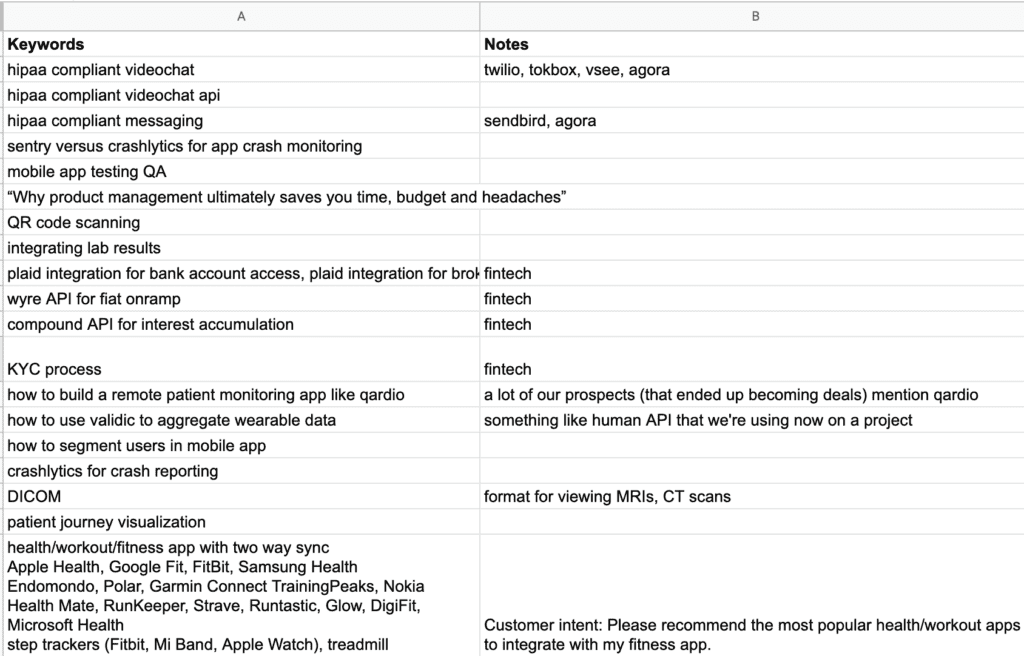 We used the above ideas, and inputted those into the Google Keyword Planner to get additional ideas based on our research.
We used the above ideas, and inputted those into the Google Keyword Planner to get additional ideas based on our research.